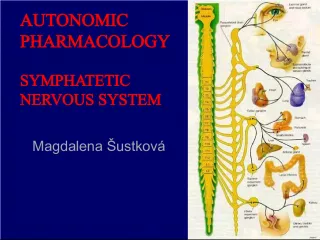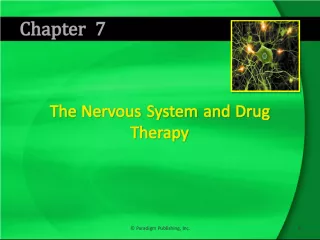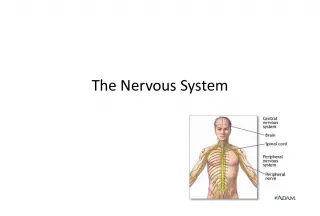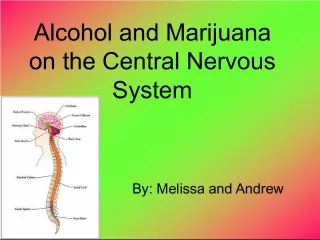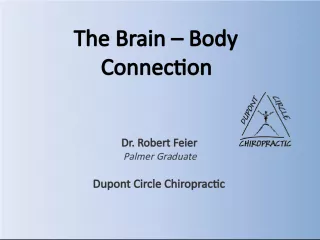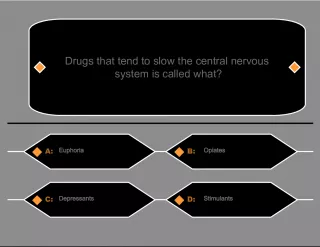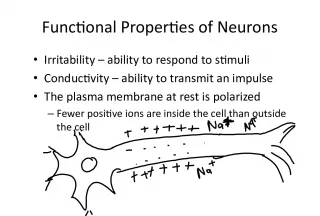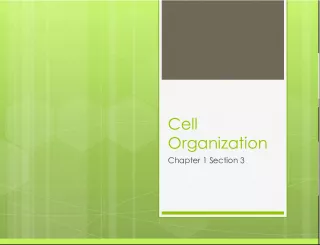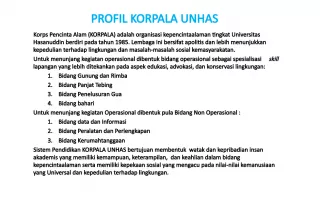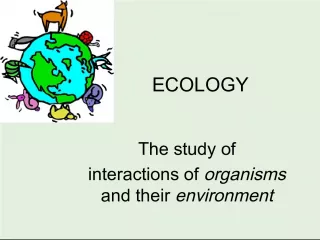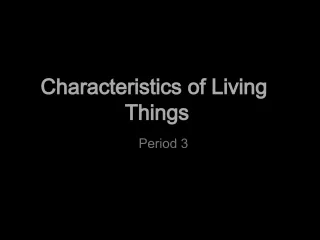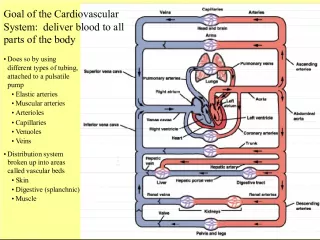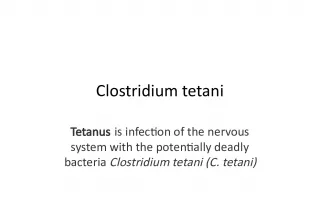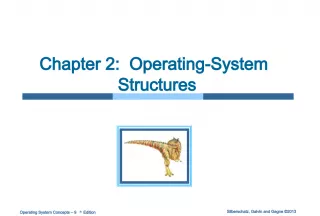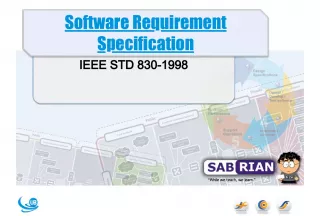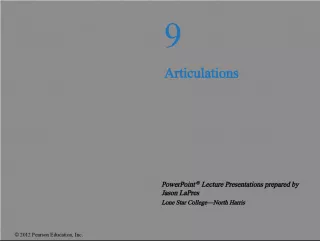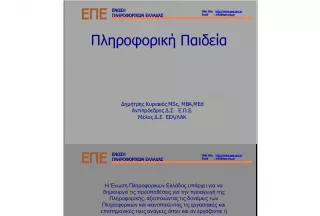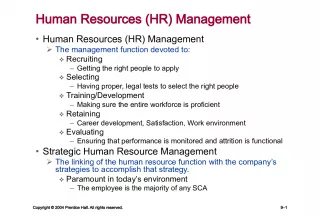Understanding the Functional Organization of the Nervous System
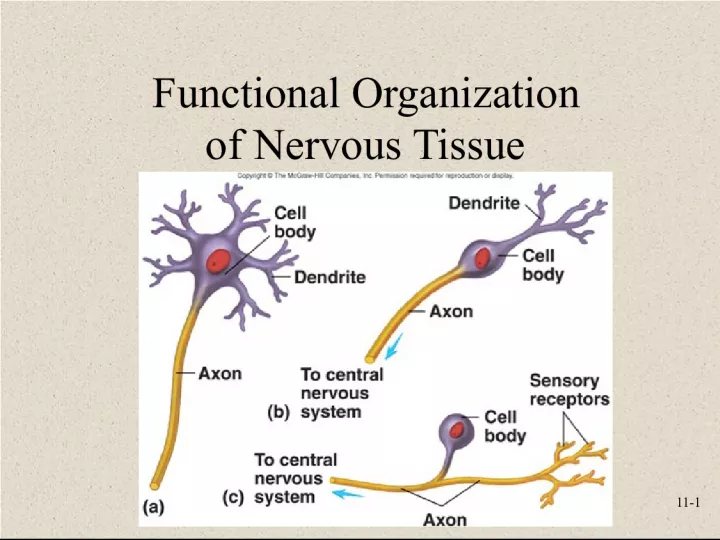

This article explains the components of the nervous system, including the brain, spinal cord, nerves, and sensory receptors. It also explores the subdivisions of the nervous system, such as the central nervous system (CNS) and the peripheral nervous system (PNS), and describes the CNS in more detail, including its location in the skull and vertebral canal.
- Uploaded on | 1 Views
-
 malcolm
malcolm
About Understanding the Functional Organization of the Nervous System
PowerPoint presentation about 'Understanding the Functional Organization of the Nervous System'. This presentation describes the topic on This article explains the components of the nervous system, including the brain, spinal cord, nerves, and sensory receptors. It also explores the subdivisions of the nervous system, such as the central nervous system (CNS) and the peripheral nervous system (PNS), and describes the CNS in more detail, including its location in the skull and vertebral canal.. The key topics included in this slideshow are nervous tissue, sensory perceptions, mental activities, muscle movements, gland secretions, brain, spinal cord, nerves, sensory receptors, CNS, PNS,. Download this presentation absolutely free.
Presentation Transcript
1. 11-1 Functional Organization of Nervous Tissue
2. 11-2 The Nervous System Components Brain, spinal cord, nerves, sensory receptors Responsible for Sensory perceptions, mental activities, stimulating muscle movements, secretions of many glands Subdivisions Central nervous system ( CNS ) Peripheral nervous system ( PNS )
3. 11-3 Central Nervous System Consists of Brain Located in cranial vault of skull Spinal cord Located in vertebral canal Brain and spinal cord Continuous with each other at foramen magnum
4. 11-4 Peripheral Nervous System Two subcategories Sensory or afferent Motor or efferent Divisions Somatic nervous system Autonomic nervous system ( ANS ) Sympathetic Parasympathetic Enteric
5. 11-5 Nervous System Organization
6. 11-6 Cells of Nervous System Neurons or nerve cells Receive stimuli and transmit action potentials Organization Cell body or soma Dendrites: Input Axons: Output Neuroglia or glial cells Support and protect neurons
7. 11-7 Types of Neurons Functional classification Sensory or afferent: Action potentials toward CNS Motor or efferent : Action potentials away from CNS Interneurons or association neurons : Within CNS from one neuron to another Structural classification Multipolar, bipolar, unipolar
8. 11-8 Neuroglia of CNS Astrocytes Regulate extracellular brain fluid composition Promote tight junctions to form blood-brain barrier Ependymal Cells Line brain ventricles and spinal cord central canal Help form choroid plexuses that secrete CSF
9. 11-9 Neuroglia of CNS Microglia Specialized macrophages Oligodendrocytes Form myelin sheaths if surround axon
10. 11-10 Neuroglia of PNS Schwann cells or neurolemmocytes Wrap around portion of only one axon to form myelin sheath Satellite cells Surround neuron cell bodies in ganglia, provide support and nutrients
11. 11-11 Myelinated and Unmyelinated Axons Myelinated axons Myelin protects and insulates axons from one another Not continuous Nodes of Ranvier Unmyelinated axons
12. 11-12 Electrical Signals Cells produce electrical signals called action potentials Transfer of information from one part of body to another Electrical properties result from ionic concentration differences across plasma membrane and permeability of membrane
13. 11-13 Sodium-Potassium Exchange Pump
14. 11-14 Membrane Permeability
15. 11-15 Ion Channels Nongated or leak channels Always open and responsible for permeability Specific for one type of ion although not absolute Gated ion channels Ligand-gated Open or close in response to ligand binding to receptor as ACh Voltage-gated Open or close in response to small voltage changes
16. 11-16 Resting Membrane Potential Characteristics Number of charged molecules and ions inside and outside cell nearly equal Concentration of K + higher inside than outside cell, Na + higher outside than inside At equilibrium there is very little movement of K+ or other ions across plasma membrane
17. 11-17 Changes in Resting Membrane Potential K + concentration gradient alterations K + membrane permeability changes Depolarization or hyperpolarization : Potential difference across membrane becomes smaller or less polar Hyperpolarization : Potential difference becomes greater or more polar Na + membrane permeability changes Changes in Extracellular Ca 2+ concentrations
18. 11-18 Local Potentials Result from Ligands binding to receptors Changes in charge across membrane Mechanical stimulation Temperature or changes Spontaneous change in permeability Graded Magnitude varies from small to large depending on stimulus strength or frequency Can summate or add onto each other
19. 11-19 Action Potentials Series of permeability changes when a local potential causes depolarization of membrane Phases Depolarization More positive Repolarization More negative All-or-none principle Camera flash system
20. 11-20 Action Potential
21. 11-21 Refractory Period Sensitivity of area to further stimulation decreases for a time Parts Absolute Complete insensitivity exists to another stimulus From beginning of action potential until near end of repolarization Relative A stronger-than-threshold stimulus can initiate another action potential
22. 11-22 Action Potential Frequency Number of potentials produced per unit of time to a stimulus Threshold stimulus Cause an action potential Maximal stimulus Submaximal stimulus Supramaximal stimulus I n s e r
23. 11-23 Action Potential Propagation
24. 11-24 Saltatory Conduction
25. 11-25 The Synapse Junction between two cells Site where action potentials in one cell cause action potentials in another cell Types Presynaptic Postsynaptic
26. 11-26 Chemical Synapses Components Presynaptic terminal Synaptic cleft Postsynaptic membrane Neurotransmitters released by action potentials in presynaptic terminal Synaptic vesicles Diffusion Postsynaptic membrane Neurotransmitter removal
27. 11-27 Neurotransmitter Removal
28. 11-28 Summation
